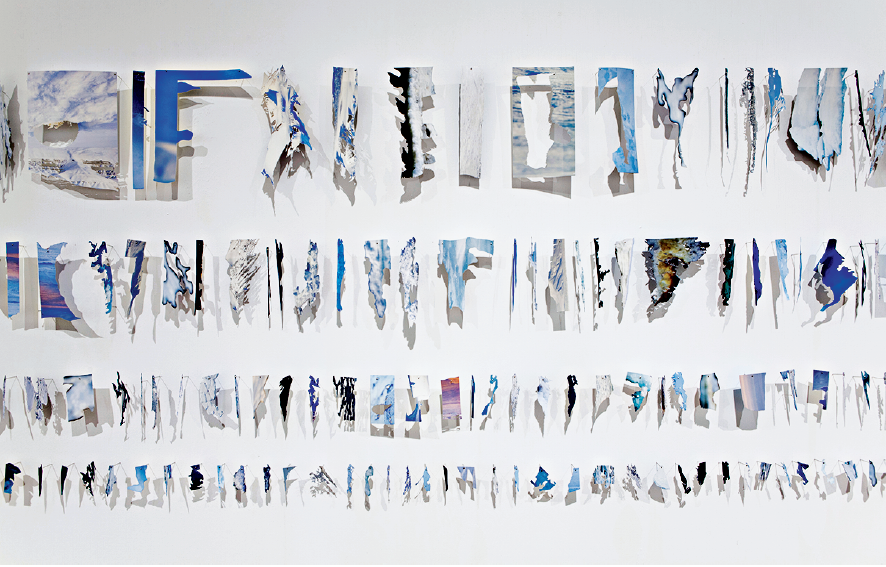Dagmara Genda
Every thing, every process, every
event or encounter is itself a
mode of becoming that has its
own time, its own movement, its
own force.
—Elizabeth Grosz, Becoming Undone, 2011
Most of us are blind to the realities of loss until it is directly upon us. There are many, if not infinite, shapes that loss can take, and the impressions they make are as varied. In “Everything That’s Lost,” Dagmara Genda uses her characteristic tracings and cut-outs to create an intimate sphere, where the space between the individual, the material and the immaterial resonates and reverberates within one another.
When one enters the gallery space for “Everything That’s Lost,” there is a force that compels. A large-scale, white, bound book stands as a marker atop a plinth in the empty space. It is pristine and monumental. Like the work of Dieter Roth, who elevated the book to a vehicle of experience in the 1960s, Dagmara Genda’s work is a sculptural object, one that generates a kind of choreographed performance.

Dagmara Genda, Everything That’s Lost, 2017, bookwork, 56 x 56 x 56 cm. Images courtesy Ace Art, Winnipeg.
In a secondary room off to one side, an array of cut-outs is mounted on a wall. Genda was gifted a book on the Arctic and from the landscapes she systematically cut out shapes of snow. There are hundreds of fragments arranged in order from largest to smallest, carefully pinned on to the gallery walls like archival specimens mounted in a collector’s vitrine. The transformative nature of cutting turns the recognizable subject into something new. John Dewey makes the distinction between perception and recognition. Whereas “recognition” is a falling back on “some previously formed interpretive schema,” he suggested, “perception” involves an active receptivity. Here, it is the cut that causes us to relinquish our preconceived interpretations of the Arctic images. The cut fragments become abstractions. Loss leaves an imprint, yet it is a mark that cannot always be identified. Removed from its original context, the image is subverted and the cut-outs become signifiers of that which was.
If not for the artist’s own explanation as to their origin and without an identifiable vestige of the discarded landscapes, the fragments exist amorphously. Incommunicable signifiers with no intimation, they form a compendium of data not easily read. Delicate yet solid, they speak less about the temporal nature of snow than about a desire to concretize something that is gone. Like memory, the cut-outs are like the recollections we habitually construct to ward off the anxiety that accompanies shifting, fleeting loss. Intriguingly, the second gallery space demonstrated the artist’s own predilection for cataloguing: the desire to systematically arrange something that is ineffable. It is the pages of the bound book that re-establish the central tenet of memory and loss.
The cut-outs are the point of departure for the pages of the bound book. From these, the artist created vector tracings, which she then laser cut into thick, square-shaped paper. The 2,038 pages are bound into a single large-scale book. Arranged in order from smallest to largest, the cut-outs form fissures and cracks among the pristine pages. This created a performative space where shapes met, overlapped and converged, all at the hand of the reader. The viewer is invited to play and engage in a dialogic reading.
The book is the centrepiece of the exhibit, the point of entry that draws the viewer in to further explore the gamut of Genda’s finical tracings and cut-outs. Its monumentality is instrumental. Like an imported monolith, it asserts its presence at the centre of the unoccupied room. There is a slowness that accompanies its monumentality; it is a disorienting and disruptive fissure, with time seeming to advance less quickly. This awakens our senses to a range of perceptual fields that we might otherwise ignore. Paper takes on a very real materiality as it bends under the weight of its hollowed-out spaces. There is a fragility that accompanies the cut material. Pages are precious, and the artist handles them with a pair of white cotton gloves. With the turn of each page, dust particles diffuse into the air. They rise and fall and flutter at a varying rate under the artificial gallery light.

Dagmara Genda, cutting out the snow, 2015, cut paper pinned to wall, dimensions variable.
Each page is a kind of heliograph; the whiteness mutates by varying degrees and shadows intensify as cut-outs morph over time. With each turn in the assemblage, new drawings are made out of collections of binaries: presence/absence, solid/ void, light/shadow. The density of perceptual experience creates a deep connection with materiality. Even the plinth, which had to be specially constructed to hold the massive object, seems to groan under the weight of its denizen. Time is implicated. And Genda programmatically instructed the gallery to flip 81 pages of the book every day of the exhibit. Duration is a dimension.
What Dagmara Genda’s work creates is an intimate cyclical sphere. The temporal nature of snow recurs through the construction of the book. With each page we engage with various states of fluidity and ambiguity. What was mass now becomes void. The book provides a blank slate and represents a rewiping of context. In this cataloguing of voids, a new site is created, one into which we might imagine. As memory fades and the original images dissolve, so do the created assemblages of forms and shadows. Like the book, memory has its own movement of making and unmaking. The distance between physical and psychological spaces merges into a constant state of becoming. It is in the subtle reverberations that the presence of the work takes form. ❚
“Everything That’s Lost” was exhibited at Ace Art, Winnipeg, from February 9 to March 16, 2018.
Elyssa Stelman lives and works in Winnipeg.

